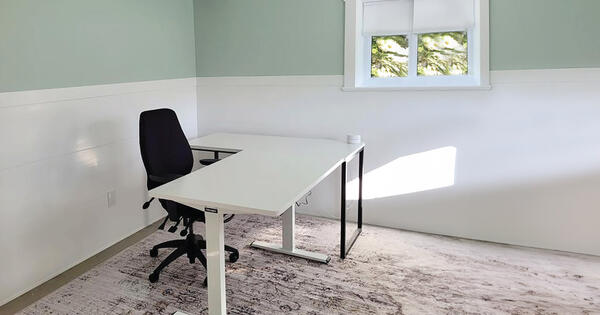This post was originally published in March 2023. Last updated: April 2025.
Basement wainscoting is a decorative and functional wall treatment that covers the lower portion of a wall, typically extending about 3 to 4 feet high. It’s a great addition to any basement because it not only enhances the look of the space but also protects walls from everyday wear and potential moisture damage. Whether you're finishing a basement or just looking to upgrade its appearance, wainscoting is a stylish and practical solution.
Wainscoting can transform a basement from a plain, utilitarian space into one that feels warm and inviting. It adds architectural detail, breaks up large expanses of wall, and creates a polished, finished look. Beyond aesthetics, it serves a functional purpose — shielding walls from scuffs, dents, and minor water exposure. Plus, with the right material, it can contribute to insulation and soundproofing, making your basement more comfortable and energy efficient.
Benefits of Wainscoting in a Basement
Basements are prone to moisture, scuffs, and damage from everyday use, making wainscoting a smart investment. Here’s why homeowners should consider it:
- Moisture and Wall Protection: Basements are naturally more humid than other parts of the home, and water damage can be a concern. Wainscoting — especially when made from moisture-resistant materials like PVC or tile — creates a protective barrier that prevents minor leaks or condensation from directly affecting drywall or framing.
- Insulation and Soundproofing: While wainscoting isn’t a full replacement for insulation, some materials can help regulate temperature and improve acoustics. Solid wood panels, MDF, and even vinyl options add a layer of thickness that helps keep cold air out and absorbs sound, making the basement quieter.
- Increased Home Value: A finished, well-designed basement adds to a home’s overall appeal, and wainscoting contributes to that polished, high-end feel. It creates a sense of craftsmanship and detail that potential buyers appreciate, making it a worthwhile upgrade if resale value is a priority.
Choosing the Right Wainscoting Material for a Basement
Since basements are more prone to humidity and temperature fluctuations, choosing the right wainscoting material is essential. Some options handle moisture better than others, so it’s important to weigh durability, maintenance, and cost before making a decision.
Popular Wainscoting Materials
Each material has its own strengths and potential drawbacks — here’s how they hold up in a basement environment:
- PVC & Vinyl Panels: PVC panels like are some of the best choices for basements because they’re completely waterproof and resistant to mold and mildew. They won’t swell, warp, or rot, making them ideal for damp conditions. Plus, they’re easy to clean and require little maintenance. The only downside? They can sometimes have a more modern or industrial look, which may not suit every design style.
- MDF & Wood Panels: Traditional wood wainscoting brings warmth and elegance to a space, but it’s not the best option for a humid basement unless it’s properly sealed. MDF (medium-density fiberboard) is more resistant to warping than natural wood, but both can absorb moisture if not treated correctly. If using wood, opt for engineered or moisture-resistant varieties, and always seal it with a high-quality paint or finish.
- Beadboard & Shiplap: These classic styles add charm and character, but they require careful material selection in a basement setting. While MDF versions of beadboard can swell when exposed to moisture, PVC beadboard is a great alternative that looks similar but resists water damage. Shiplap, if made from wood, should be sealed or used in drier basement areas to prevent warping over time.
- Tile or Stone Wainscoting: This is the most durable and moisture-resistant option, making it perfect for basements with higher humidity levels. Tile or stone wainscoting won’t rot, warp, or develop mold, and it provides a high-end, elegant look. The downside? It’s one of the most expensive materials, both in terms of material costs and installation labor. However, if longevity and durability are top priorities, it may be worth the investment.


Design and Style Ideas for Basement Wainscoting
The right wainscoting style can completely transform a basement, making it feel more inviting and polished. Whether you’re going for a cozy, modern, or rustic look, there’s a style to suit your space.
When it comes to color and finish, wainscoting can be painted, stained, or left as-is if using prefinished panels like PVC. Paint is a great option for brightening up a basement and making the space feel larger, while stain brings out the natural beauty of wood for a warmer, more traditional feel. If durability is a concern — especially in a basement that sees a lot of moisture — painted finishes with mold-resistant coatings or waterproof PVC panels are the best choices.
As for height, wainscoting typically covers the lower third of a wall, but it can extend higher for a more dramatic effect. Standard heights range from 32 to 48 inches, but going taller — up to 60 inches — can add a more luxurious feel.
Basement Wainscoting Style Ideas
Here are some wainscoting styles that work well in a basement:
- Classic Beadboard for a Cozy Look: Beadboard is a timeless choice that adds texture and warmth to a basement. It works well in traditional, coastal, or cottage-style spaces and can be painted in light colors to keep the room feeling bright.
- Modern Board and Batten for a Sleek Style: This style features clean vertical lines that add depth and interest to basement walls. It’s ideal for modern or transitional designs and looks especially striking in neutral colors like white, gray, or deep blue.
- Rustic Shiplap for a Farmhouse Feel: Shiplap wainscoting creates a rustic, farmhouse-inspired look that’s perfect for cozy basement spaces. It can be painted for a crisp, clean aesthetic or stained to enhance the natural wood grain.
- Durable PVC Panels for a Waterproof Solution: If moisture is a concern, PVC wainscoting panels offer a sleek and practical alternative. Available in neutral colors like white and gray, they’re prefinished, bright, and resistant to mold and mildew — making them perfect for dark basements that are prone to dampness.
- Painted vs. Stained Finishes: Painted wainscoting offers more flexibility in color choices and helps reflect light, which is great for basements with limited natural light. Stained finishes, on the other hand, bring warmth and depth, making them a great option for home theaters or lounge areas.
Installing Basement Wainscoting: DIY vs. Hiring a Pro
Installing wainscoting in a basement can be a rewarding project, but whether it’s DIY-friendly depends on the material and your skill level. While simpler options like PVC panels or beadboard can be installed with basic tools, more intricate styles — like board and batten or tile wainscoting — may require professional expertise.
If you’re considering a DIY approach, here’s what you’ll need:
- Tools & Materials: A tape measure, level, saw (circular or miter), nail gun or adhesive, caulk, and paint or stain. For heavier materials like tile or stone, you’ll also need mortar and grout.
- When to Hire a Professional: If your basement has uneven walls, excessive moisture issues, or you’re using a heavy material like stone or tile, hiring a pro ensures a flawless finish. Professionals also have the experience to properly seal and install wainscoting in damp environments, reducing the risk of long-term damage.
Trusscore Wall&CeilingBoard: A Moisture-Resistant Wainscoting Solution
Traditional wainscoting materials can struggle in basement environments, especially when moisture or flooding is a concern. That’s where Trusscore Wall&CeilingBoard stands out — it’s a PVC-based paneling solution that’s completely waterproof, mold-resistant, and far more durable than wood or MDF.
Here’s how it compares to traditional options:
- Waterproof & Mold-Resistant: Unlike wood or MDF, Trusscore Wall&CeilingBoard won’t warp, rot, or develop mold when exposed to moisture. It’s ideal for basements where humidity and occasional leaks can be a problem.
- No Painting or Finishing Required: The panels come pre-finished with a bright, clean look, eliminating the need for paint, stain, or sealant. That means less maintenance and no peeling or chipping over time.
- Easy Installation: Compared to wood wainscoting, which requires cutting, sanding, and painting, Trusscore panels install quickly with a simple interlocking system. They can be mounted directly over studs or drywall, reducing installation time and effort.
- Seamless Integration with Other Wall Treatments: Trusscore Wall&CeilingBoard pairs well with other basement wall finishes, like painted drywall, tile, or even decorative trim. It can also be used on both walls and ceilings for a cohesive, modern look.
For homeowners who want the look of wainscoting without the hassle of maintenance, Trusscore Wall&CeilingBoard is a smart, long-lasting choice.



Maintenance and Upkeep of Basement Wainscoting
Keeping basement wainscoting in good shape doesn’t have to be a hassle — choosing the right material and finish upfront can make maintenance much easier. Regular cleaning and occasional touch-ups will help ensure that your wainscoting stays looking great for years to come.
How to Clean and Maintain Different Wainscoting Materials
Each material has its own cleaning and maintenance needs:
- PVC & Vinyl Panels: These are the easiest to maintain. A damp cloth and mild soap will remove dust and grime. Since they’re waterproof, they won’t absorb moisture or develop mold.
- MDF & Wood Panels: Dust regularly and wipe with a slightly damp cloth. Avoid excessive moisture, as wood and MDF can swell or warp over time. If painted, use a gentle cleaner to prevent peeling.
- Beadboard & Shiplap: Painted beadboard and shiplap can be cleaned with a damp cloth, but it’s best to use a finish with a protective topcoat to prevent stains.
- Tile or Stone Wainscoting: These are highly durable but may require periodic grout cleaning. Sealing natural stone helps prevent stains and water absorption.
What to Do If Basement Wainscoting Gets Damaged
Accidents happen, and knowing how to fix minor damage can extend the life of your wainscoting. The right repair approach depends on the material and type of damage:
- Scratches & Scuffs: For minor surface marks on painted wood or PVC use a touch-up pen, matching paint, or a stain marker to blend the blemish. For deeper scratches, lightly sand the area before applying a new coat of paint or finish.
- Warping or Water Damage: If wood or MDF panels start to warp, buckle, or swell, they may need to be replaced — especially if moisture has penetrated the material. Prevent future damage by sealing panel edges before installation and ensuring proper basement humidity control. PVC-based panels, like Trusscore Wall&CeilingBoard, won’t warp, making them a more durable option in moisture-prone spaces.
- Cracks or Loose Panels: Small cracks in wood or MDF can be filled with caulk or wood filler, then sanded and repainted. If panels are coming loose, reattach them using construction adhesive or nails, ensuring they sit flush against the wall. For significant movement or gaps, check for underlying moisture issues that could be affecting adhesion.
Finishes That Make Maintenance Easier
Choosing the right finish for your basement wainscoting can make cleaning and upkeep simpler while helping prevent long-term damage:
- Satin or Semi-Gloss Paint: Ideal for painted wood and MDF, these finishes are easier to wipe clean than matte or flat paints and hold up well in high-traffic areas. They also resist stains and moisture better than flat finishes.
- Waterproof Sealants: Essential for wood and MDF wainscoting in basements, a high-quality sealant helps prevent moisture absorption and extends the lifespan of the material. Reapply as needed, especially in areas prone to spills or humidity changes.
- Prefinished Panels (Like Trusscore): PVC-based panels require little to no maintenance, as they won’t absorb moisture, warp, or need repainting. Their smooth surface can be wiped clean with a damp cloth, making them a hassle-free option for basements.
Basement wainscoting is a practical and stylish way to upgrade your space, offering both protection and design appeal. Choosing the right material depends on your budget, the level of moisture in your basement, and how much maintenance you’re willing to do.
To make the best decision:
- Consider moisture resistance: PVC and tile hold up best in damp conditions, while wood and MDF need proper sealing.
- Match the style to your home: Beadboard offers a classic look, board and batten adds a modern touch, and shiplap creates a rustic feel.
- Think about installation: DIY-friendly options like beadboard or PVC panels save money, while complex installations may require a professional.
By weighing these factors, you can choose a wainscoting solution that enhances your basement while staying within your budget and maintenance preferences.






